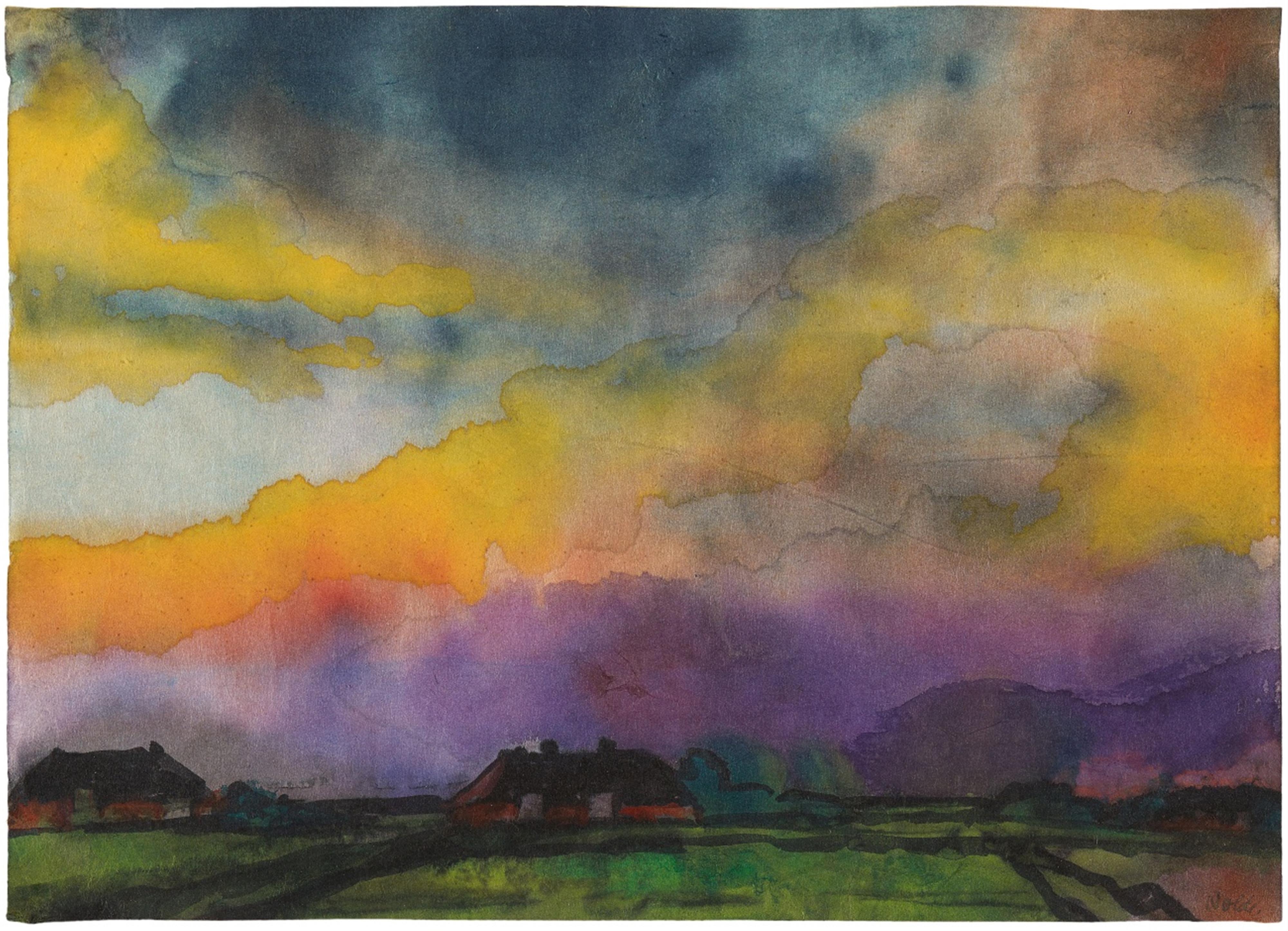Emil Nolde
Weite Marschlandschaft mit Bauernhöfen
Circa 1930/1935
Watercolour on fibrous Japan laid paper 32.8 x 45.5 cm Framed under glass. Signed 'Nolde.' in black pen lower right. - The sheet very minimally irregularly cut. In fine condition. - The old frame backing with the imprinted label from "Commertschen Kunsthandlung", Hamburg.
According to Manfred Reuther the motif of this landscape shows the Friesian marsh in Gotteskoog, with the large farmsteads surrounding Seebüll. In 1927 the artist had a new home and studio based on his own designs built on the high ground of the Seebüll terp. In the years that followed - around 1930 and in the early 1930s - he painted a number of large marsh landscapes recording his new surroundings and their topography. In his memoirs Nolde precisely describes the communities around him according to the four directions and lists them by name. He also captures the impression dominating over everything: “We stand on our Seebüll terp, the entire broad dome of the heavens above us, curving round even more than a semicircle, because it is odd how much a little elevation on a flat plain enlarges the arc of the heavens.” (Emil Nolde, Seebüll 1928, in: Mein Leben, Cologne 1976, p. 373).
“His homeland is the country along the sea between Tondern and the village of Nolde, with Ruttebüll, Rosenkranz, Utenwarf and Seebüll. A peculiar country that still belonged to the sea for part of the 16th century: it was a tidal flat with a few inhabited Halligen islands, wide tidal creeks and fluid mud, and it was flooded by the North Sea with the changing of the tides. Then came the building of dykes and their destruction through storm surges: an eternal struggle whose terrors remained palpable for people down to the most recent past. Even when the dykes provided protection against the surge of the sea, the danger of flooding had not been banished, because the land lay too low. The many lakes and the rivers flowing into the North Sea could not hold the masses of water coming from the uplands of the geest: from autumn to spring everything was extensively flooded. Then, the lonely farmsteads on the Halligen and terps stood like islands in the sea, and the boat outside the door of their home became the only means of transportation. That is what the landscape was still like thirty or forty years ago: a primordial landscape of strange beauty.” (Martin Urban, Emil Nolde - Landschaften, Aquarelle und Zeichnungen, Cologne 1969, p. 26).
The paintings and watercolours created after this “primordial landscape” at that time are now undisputed masterworks within Emil Nolde's oeuvre. They are characterised by the intense and expressive tonalities of entirely different atmospheres and moods. In the present work the red farmhouses, with the long ridges of their roofs, lie on the distant horizon in the midst of green land saturated with moisture. Nolde uses narrow and dark outlines to emphasise the contours, and he suggests the ditches running throughout the landscape. In the play of clouds and light high in the sky - which is brighter here - rich fireworks of complementary colours unfold, with yellow and orange accompanied by blue and violet. The watercolour's overwhelming chromatic effect translates the felt power of nature's infinite theatre, which is constantly changing, constantly renewed.
Certificate
With a photo-certificate by Manfred Reuther, Klockries, dated 31 March 2017; the work is registered under the archive number "Nolde A-14/2017".
Provenance
Commetersche Kunsthandlung (Wilhelm Suhr), Hamburg (acquired there); Private possession since, North Germany

